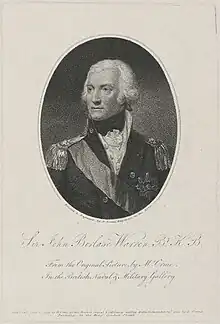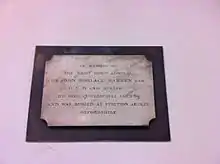John Borlase Warren
Admiral Sir John Borlase Warren, 1st Baronet GCB GCH PC (2 September 1753 – 27 February 1822) was a British Royal Navy officer, diplomat and politician who sat in the House of Commons between 1774 and 1807.
Sir John Borlase Warren | |
|---|---|
 Sir John Borlase Warren, by Daniel Orme, 1799 | |
| Born | 2 September 1753 Stapleford, Nottinghamshire, England |
| Died | 27 February 1822 (aged 68) Greenwich Hospital, London[1] |
| Allegiance | United Kingdom |
| Service/ | Royal Navy |
| Years of service | 1771–1822 |
| Rank | Admiral |
| Commands held | HMS Helena HMS Ariadne HMS Winchester HMS Flora Western Squadron HMS Pomone HMS Canada North America Station |
| Battles/wars | |
| Spouse(s) | Caroline Clavering |
| Relations | George Venables-Vernon, 5th Baron Vernon (grandson) |
Naval career
Born in Stapleford, Nottinghamshire, he was the son and heir of John Borlase Warren (died 1763[2]) of Stapleford and Little Marlow. He entered Emmanuel College, Cambridge in 1769, but in 1771 entered the navy as an able seaman;[3] in 1774 he became member of Parliament for Great Marlow; and in 1775 he was created a baronet, the baronetcy held by his ancestors, the Borlases, having become extinct in 1689.
Career

His career as a seaman really began in 1777, and two years later he obtained command of a ship. On 23 April 1794, as Commodore of the frigate squadron off the north-west French coast assisting in the blockade of Brest, Warren and his squadron captured a number of French frigates.[1] In 1795, he commanded one of the two squadrons carrying troops for the Quiberon expedition and in 1796 his frigate squadron off Brest is said to have captured or destroyed 220 vessels.[1] In October 1798, a French fleet—carrying 5,000 men—sailed from Brest intending to invade Ireland.[1] The plan was frustrated in no small part due to the squadron under his command during the action of 12 October 1798 off Donegal.
Diplomatic career
In 1802, he was sworn of the Privy Council and sent to St. Petersburg as ambassador extraordinary,[1] but he did not forsake the sea. In 1806 he captured a large French warship, the Marengo, at the action of 13 March 1806. He was commander-in-chief on the North American Station from 1807 to 1810.[1] He became an admiral in 1810, and was commander-in-chief on this Station again from 1813 to 1814.[1] While in Halifax he determined the late commander John Shortland's dog had been stolen from London and brought to Halifax.[4] He had the dog returned to London to Shortland's widow. During the British invasion of Maryland in 1814, he led a detail of British troops that occupied Havre de Grace and set fire to much of the town, including the home of Commodore John Rodgers.[5]
Personal life
%252C_Lady_Vernon_-_653171_-_National_Trust.jpg.webp)
On 12 December 1780, he married Caroline Clavering, a daughter of Lt.-Gen. Sir John Clavering. She died in 1839.
He died on 27 February 1822. His two sons predeceased him. His daughter and heiress, Frances Maria Warren (1784–1837), married George Venables-Vernon, 4th Baron Vernon. Their son was George Venables-Vernon, 5th Baron Vernon.
Legacy
There is a monument to him in St Mary's Church, Attenborough in Nottinghamshire. A popular figure in the area of his birth, there are a number of pubs named after him in Nottingham and nearby towns.
Notes
- Biography at the Dictionary of Canadian Biography Online
- Stanford University,
- "Warren, John Borlase (WRN769JB)". A Cambridge Alumni Database. University of Cambridge.
- King, R.N., Lt. William Elletson (1811). The Naval Chronicle (1799-1818): Containing a general and biographical history of the royal navy of the United kingdom with a variety of original papers on nautical subjects. London: J. Gold. p. 197. Retrieved 5 October 2023.
- Paullin, Charles Oscar (1910). Commodore John Rodgers: Captain, Commodore, and Senior Officer of the American Navy, 1773-1838. Arthur H. Clark Company. pp. 279–280. Retrieved 5 October 2023.
References
- Biography at the Dictionary of Canadian Biography Online
- This article incorporates text from a publication now in the public domain: Chisholm, Hugh, ed. (1911). "Warren, Sir John Borlase". Encyclopædia Britannica. Vol. 28 (11th ed.). Cambridge University Press.